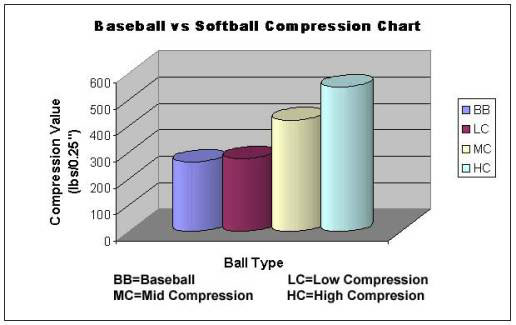|
by Dr. Mark McDowell |
|
|
* How Ball Circumference And Compression Affect Pitcher Response Time!!!
* How Temperature Affects Ball Compression
After recently doing ball compression testing on baseballs, I noticed that while the average compression for baseballs has gone down about 15% in the past few years, the average compression value for softballs has not changed much. Based on our initial study in 1997 on Softball vs Baseball testing, the average polyurethane softball was 1.4 times harder than a baseball. Based on our testing for 2001 balls, the average polyurethane softball is 1.6 times harder than a baseball. This is a disturbing trend that absolutely needs to be controlled based on recent reported injuries and at
|
|
|
|
|
|
|
|
|
|
|
|
|
|
||
|
|
|
|
|
|
|
|
|
|
||
|
|
|
|
|
|
|
|

For the 2002 season, the compression values are now required to be posted on balls for at least one association. This is a good step in the right direction but the Compression values are still too high for all levels of play. The COR of the ball is still irrelevant today and is not an indication as to the liveliness of the ball. The compression and circumference are the two most important things to look at when considering a ball purchase for league or tournament play.
An interesting fact to note is that the average
softball player is getting older, not younger, which leads one to believe
that pitcher response time is one of the biggest issues that has not been
dealt with yet to control the safety of the game. This issue needs
to be addressed so that all pitchers feel safe when they go out on the
mound.
1) I recommend that the compression value of a softball not exceed 425 +/-25pqi. This should be mandated for all levels of play. This will give players a good opportunity to enjoy the game and keep it safe. Most pitchers can react to a batted ball in the 425pqi range. If you are concerned about too many home runs, then use a lower compression ball. The 425 +/-25pqi value is recommended over using just low compression balls (375pqi maximum or the BPF recommended value) in order to compensate for decreased compression values in warmer areas of the country.
2) Take away the rules the outlaw/ban multi-wall bats because too many bat companies are getting around the issue by making multi-wall bats and calling them single-wall bats.
3) No hitting the middle rules need to be instituted in league play. I am very much in favor of putting a screen/net in front of the pitcher’s mound the same width of the mound and if you hit the net, it’s a dead ball and the batter is automatically OUT!!! The pitcher is the most vulnerable person on the field and has to be protected.
4) If the home runs are up and a player hits a home run, the inning is over. This will make games go very fast and allow for correct classification of teams on all levels. There are too many sandbagging teams throughout the country.
www.bomani.com
Copyright © 2010 Bomani Sports Research, Inc.